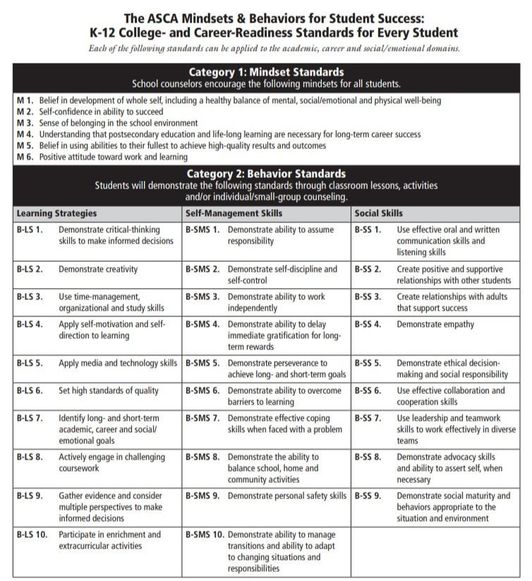Mission
Statement
The
Yorkshire
Elementary
School
Counseling
Program
strives
to
be
a
collaborative
community
that
supports
the
whole
child.
We
use
data-informed
practices
and
interventions
so
that
students
have
access
to
a
world-class
education
and
can
achieve
individualized
personal
/
social,
career
and
academic
success
that
is
necessary
to
develop
strong
character
and
achieve
optimal
success.
Vision
Statement
The
Yorkshire
Elementary
School
Counseling
Program
envisions
a
future
in
which
all
students
learn
to
their
fullest
potential
and
exhibit
qualities
of
a
leader.
Students
from
our
school
are
successful
lifelong
learners
and
productive
citizens
throughout
their
educational
career
and
beyond.
Beliefs
and
Philosophy
Statement
The
professional
school
counselors
at
Yorkshire
believe
that:
-
All
students
can
achieve
and
will
succeed.
-
All
students
should
be
supported
to
meet
the
needs
of
the
whole
child.
-
All
students
deserve
equitable
access
to
a
world-class
education.
-
The
school
counselors
will
collaborate
with
all
stakeholders
&
coordinate
opportunities
for
growth
academically,
socially,
and
emotionally
in
every
student.
-
The
school
counselors
will
gather
and
analyze
data
to
deliver
appropriate
services.
-
The
school
counselors
will
use
research-based
programs
to
achieve
program
goals.
-
The
school
counselors
will
apply
the
ASCA
professional
school
counseling
standards
and
ethics.
-
The
school
counselors
will
maintain
culturally
responsive
practices.
-
The
Yorkshire
School
Counseling
Advisory
Committee
(school
counselors,
administration,
staff,
parents,
and
community
members)
will
reflect
annually
to
define,
manage,
deliver
and
assess
the
school
counseling
program.

Elementary
Guidance
Curriculum
GRADE
LEVEL
OBJECTIVES
KINDERGARTEN
KA.1:
Understand
responsibilities
of
being
a
student
worker
in
school.
KC.1:
Identify
areas
of
interest
and
one's
unique
abilities.
KC.2:
Demonstrate
awareness
of
careers
in
the
community.
KP.1:
Identify
areas
of
interest
and
one's
unique
abilities.
KP.2:
Identify
and
appropriately
express
various
feeling
words.
KP.3:
Distinguish
between
appropriate
and
inappropriate
behavior
in
school.
KP.4:
Use
appropriate
communication
skills
to
ask
for
help
when
needed.
KP.5:
Demonstrate
awareness
of
empathy
and
bully
prevention
skills
and
strategies.
FIRST
GRADE
1A.1:
Demonstrate
positive
work
habits
by
paying
attention,
following
directions,
and
completing
tasks.
1A.2:
Understand
the
importance
of
goal
setting.
1A.3:
Understand
that
mistakes
are
essential
to
the
learning
process.
1C.1:
Develop
an
understanding
of
roles
and
contributions
of
workers
in
school,
home,
and
community.
1C.2:
Identify
personal
skills,
abilities,
and
interests
in
the
areas
of
academic,
career,
and
personal/social
development.
1P.1:
Describe
how
to
express
feelings
in
constructive
ways
(i.e.
"I
statements.")
1P.2:
Demonstrate
an
awareness
of
the
importance
of
personal
safety
(i.e.
Know
telephone
number,
home
address,
emergency
contact
information,
safety
plan,
Stranger
Danger.)
1P.3:
Identify
situations
requiring
adult
professional
help
(tattling
vs.
reporting.)
1P.4:
Demonstrate
awareness
of
empathy
and
bully
prevention
skills.
SECOND
GRADE
2A.1:
Demonstrate
goal-setting
steps.
2A.2:
Recognize
the
relationship
between
goal
setting
and
accomplishing
work.
2A.3:
Achieve
academic
success
by
working
independently.
2A.4:
Identify
test-taking
skills
to
be
utilized.
2C.1:
Learn
about
the
variety
of
traditional
and
non-traditional
occupations
in
a
changing
work
place.
2C.2:
Identify
resource
people
in
the
school
and
community
and
know
how
to
seek
their
help.
2P.1:
Identify
forms
of
communication
(e.g.,
listening,
speaking,
body
language,
etc.)
2P.2:
Demonstrate
awareness
of
diverse
differences.
2P.3:
Understand
how
to
make
and
keep
friends.
2P.4:
Recognize
how
personal
behavior
affects
group
dynamics
and
show
how
to
work
cooperatively.
2P.5:
Recognize
peer
pressure
and
bullying
situations.
2P.6:
Recognize
different
coping
strategies
to
deal
with
situations.
THIRD
GRADE
3A.1:
Set
realistic
short-term
goals.
3A.2:
Describe
the
relationship
between
learning/achievement
and
individual
effort
(work
ethic.)
3A.3:
Identify
study
skills
to
be
utilized.
3A.4:
Identify
organizational
skills
to
be
utilized.
3A.5:
Identify
test-taking
skills
to
be
utilized.
3A.6:
Work
cooperatively
in
small
and
large
groups
towards
a
common
goal.
3C.1:
Identify
attitudes
and
behaviors
which
lead
to
successful
learning
and
productivity.
3C.2:
Recognize
that
skills,
abilities,
and
interests
are
considerations
in
the
choice
of
careers.
3C.3:
Understand
that
jobs
with
similar
characteristics
may
be
grouped
as
job
families
or
career
clusters.
3P.1:
Identify
different
modes
of
interpersonal
communication
(written,
verbal,
and
non-verbal).
3P.2:
Demonstrate
how
to
positively
communicate
thoughts,
feelings,
and
needs
to
others
in
a
variety
of
situations.
3P.3:
Describe
the
importance
of
accepting
responsibility
for
individual
behavior
and
its
effect
on
others.
3P.4:
Demonstrate
self-control.
3P.5:
Demonstrate
how
to
communicate
positively
in
conflict
and
bullying
situations.
3P.6:
Explain
the
skills
needed
to
function
effectively
in
groups.
3P.7:
Identify
the
decision-making
process.
3P.8:
Identify
and
demonstrate
respectful
behavior
characteristics
toward
students
in
a
diverse
population.
FOURTH
GRADE
4A.1:
Identify
and
describe
how
decision-making,
problem-solving,
and
coping
skills
support
or
interfere
with
academic
achievement.
4A.2:
Identify
effective
test-taking
skills
to
utilize.
4A.3:
Demonstrate
time
management
and
organizational
skills.
4A.4:
Understand
how
personal
learning
styles
can
impact
school
achievement.
4C.1:
Identify
hobbies
and
interests.
4C.2:
Relate
each
step
of
the
decision-making/problem-solving
process
to
career
development
(awareness,
exploration,
and
preparation).
4P.1:
Demonstrate
methods
of
appropriately
expressing
feelings
and
handling
conflict
in
a
peaceful
and
safe
way.
4P.2:
Identify
factors
that
influence
personal
decisions.
4P.3:
Demonstrate
the
decision-making
process
by
generating
alternative
solutions
to
problems
and
considering/evaluating
consequences.
4P.4:
Recognize
that
group
members
may
have
differing
opinions.
4P.5:
Demonstrate
different
coping
strategies
for
various
situations
and
life
changes.
4P.6:
Identify
factors
that
impact
personal
safety,
self-reliance,
and
well-being
(i.e.
substance
abuse,
bullying,
etc.)
FIFTH
GRADE
5A.1:
Set
realistic
long-term
goals.
5A.2:
Apply
personal
learning
style.
5A.3:
Recognize
the
benefits
of
individual
initiative
and
teamwork.
5C.1:
Compile
a
list
of
personal
abilities.
5C.2:
Describe
how
personal
strengths
in
school
work
affect
future
goals
and
career
options.
5C.3:
Understand
that
the
changing
workplace
requires
lifelong
learning
and
acquiring
new
skills.
5C.4:
Acquire
employability
skills
such
as
teamwork,
problem-solving,
and
organization.
5C.5:
Identify
career
choices
through
various
means
of
exploration.
5C.6:
Describe
changes
as
inevitable
and
necessary
to
adapt
to
new
situations,
(e.g.,
middle
school).
5P.1:
Describe
how
verbal
and
non-verbal
behavior
influence
interpersonal
relationships.
5P.2:
Demonstrate
how
to
communicate
with
others.
5P.3:
Demonstrate
appreciation
and
respect
for
similarities
and
differences.
5P.4:
Describe
strategies
for
getting
along
with
others.
5P.5:
Demonstrate
how
to
disagree
with
others
without
provoking
them.
5P.6:
Demonstrate
appropriate
responses
to
ease
conflict
and
bullying
situations.
5P.7:
Demonstrate
effective
responses
to
peer
pressure.
5P.8:
Identify
and
analyze
group
dynamics
in
a
variety
of
situations.

